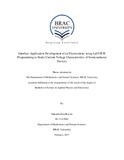| dc.contributor.advisor | H. Haque, Firoze | |
| dc.contributor.author | Karim, Khondker Jeaul | |
| dc.date.accessioned | 2017-05-30T04:04:28Z | |
| dc.date.available | 2017-05-30T04:04:28Z | |
| dc.date.copyright | 2016 | |
| dc.date.issued | 2017-02 | |
| dc.identifier.other | ID 11215002 | |
| dc.identifier.uri | http://hdl.handle.net/10361/8202 | |
| dc.description | This Thesis is submitted in partial fulfillment of the requirements for the degree of Bachelor of Applied Physics and Electronics, 2016. | en_US |
| dc.description | Cataloged from PDF version of Thesis. | |
| dc.description | Includes bibliographical references (page 61). | |
| dc.description.abstract | A transistor is an electrical device made of semiconductor material that is used for operations such as amplification and switching of electronic signals and electrical power. Transistors, such as Bipolar Junction Transistor (BJT) and Metal-Oxide Semiconductor Field-Effect Transistor (MOSFET), are used extensively in electrical circuits in applications for a diverse range of electrical devices and systems from mobile phones to computers. In order for a transistor to be used effectively and perform functions as amplifiers and switches, it is important to know its electrical properties and operational specifications as it needs to be adaptable to the circuit’s current/voltage limits and other operating conditions. An electrometer, which is in fact a specialized measuring instrument with numerous applications, can be used to measure the current readings of a transistor subjected to different levels of voltages. For the electrometer to function most efficiently, an application is made using LabVIEW software which allows for its remote access to accomplish functions such as conducting a voltage sweep (applying incremental voltages after short delays and recording the current). This simultaneously decreases the data acquisition time drastically and eliminates the factor of human error completely while taking readings, as the electrometer is software-controlled. Such an application, coupled with the electrometer itself,promotes an efficient way of making a voltage sweep and displaying a graph of the input and output from the data obtained simultaneously. This enables the characterization of the transistors and the data can be used to identify whether the transistor, with its own specifications and boundaries, can be used in a particular system or circuit. | en_US |
| dc.description.statementofresponsibility | Khondker Jeaul Karim | |
| dc.format.extent | 61 pages | |
| dc.language.iso | en | en_US |
| dc.publisher | BRAC University | en_US |
| dc.rights | BRAC University thesis are protected by copyright. They may be viewed from this source for any purpose, but reproduction or distribution in any format is prohibited without written permission. | |
| dc.subject | LabVIEW | en_US |
| dc.subject | Electrometer | en_US |
| dc.subject | Mini-Coater | en_US |
| dc.title | Interface application development of an electrometer using LabVIEW programming to study current-voltage characteristics of semiconductor devices | en_US |
| dc.type | Thesis | en_US |
| dc.contributor.department | Department of Mathematics and Natural Sciences, BRAC University | |
| dc.description.degree | B. Applied Physics and Electronics | |

